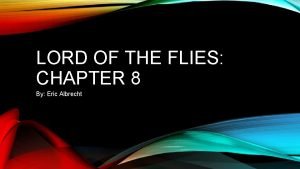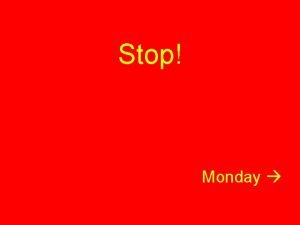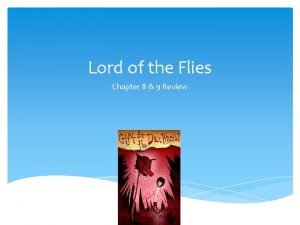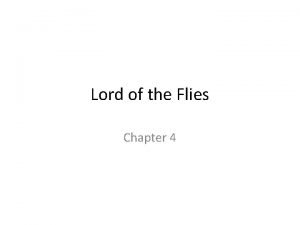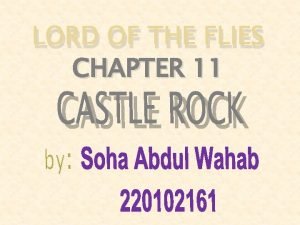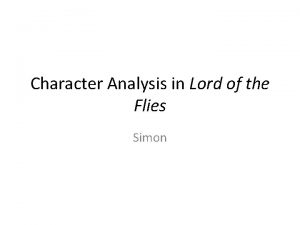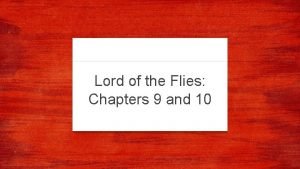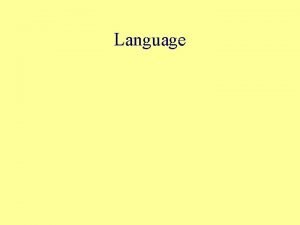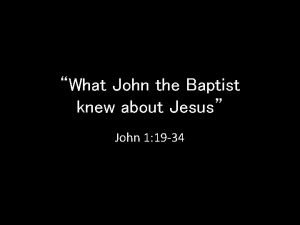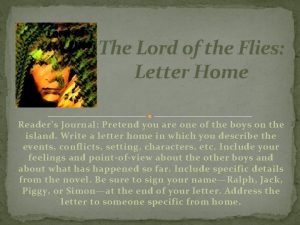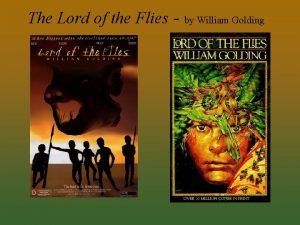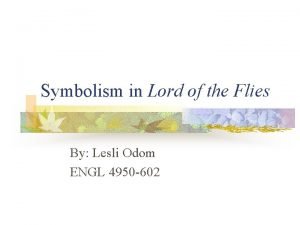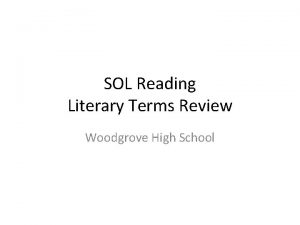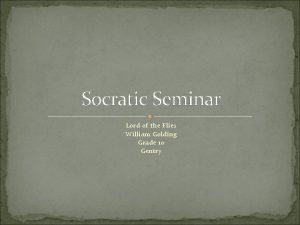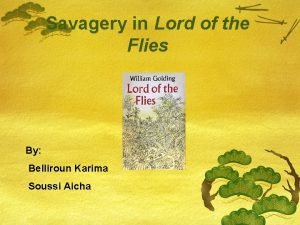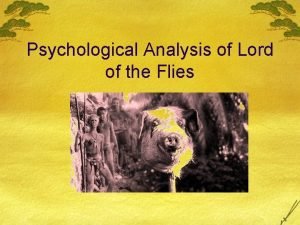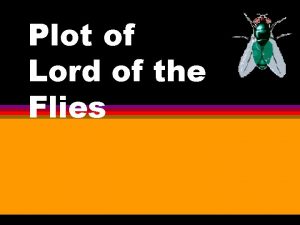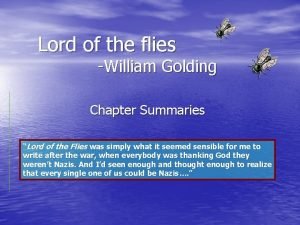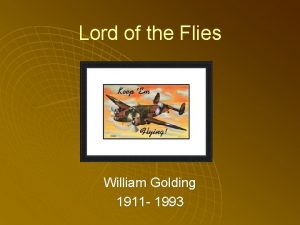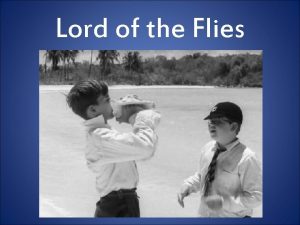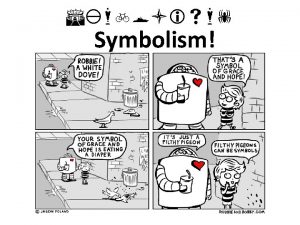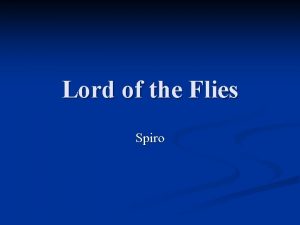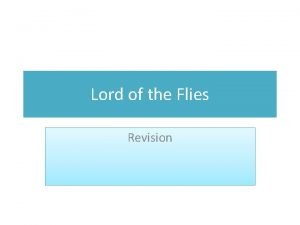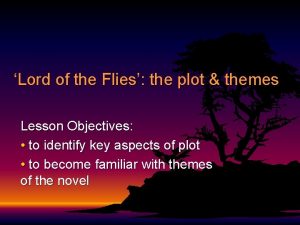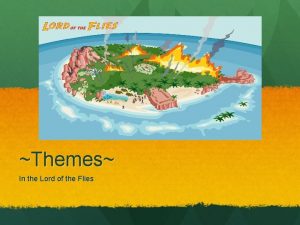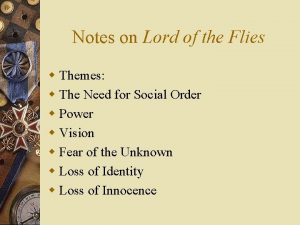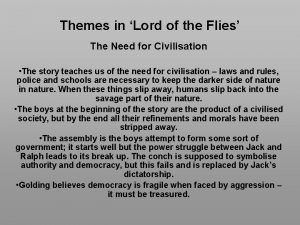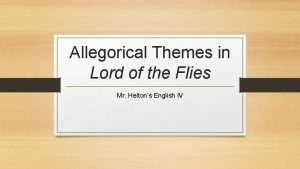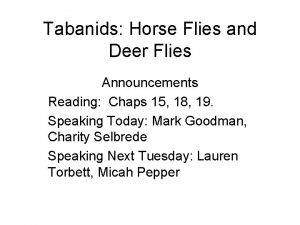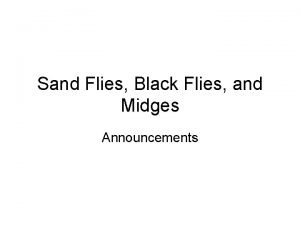Lord of the Flies Analysis Themes Themes are



















- Slides: 19

Lord of the Flies Analysis

Themes • Themes are the fundamental and often universal ideas explored in a literary work.

Civilization vs. Savagery • to live by rules, moral commands or • to gratify immediate desires, • obtain supremacy • control power

Contd. • civilization vs. savagery, • order vs. chaos • reason vs. impulse • law vs. anarchy • good vs. evil.

Examples • P. 1: Introduction to characters – Ralph – Piggy • P. 40 the dissolution of the young English boys' civilized, moral, disciplined behavior to a wild, brutal, barbaric life in the jungle.

Examples contd. • Ralph, the protagonist, who represents order and leadership; • Jack, the antagonist, who represents savagery and the desire for power.

The Wreckage • Piggy, no savage feelings • Roger seems barely capable of comprehending the rules of civilization. • Golding: savagery more primal and fundamental • Civilization: moral behavior forced upon the individual rather than a natural expression of human individuality.

The Human Heart • revert to cruelty, savagery, and barbarism. • innate human evil • finds expression: the beast, the sow's head on the stake. • only Simon seems innately good.

Loss of Innocence • well-behaved, orderly • to cruel, bloodthirsty hunters • Chapter 12: hunted, tortured, and killed animals and human beings • Chapter 3: guileless children swimming in the lagoon. • What other ways have the boys lost innocence?

Motifs • Motifs are recurring structures, contrasts, or literary devices that can help to develop and inform the text's major themes.

Biblical Parallels • subtle motif in the novel, adding thematic resonance to the main ideas of the story. • The island: Eden • the Lord of the Flies: Beelzebub • Simon: Martyr or Christ figure. • Conversation: forty days in the wilderness.

Symbols • Symbols are objects, characters, figures, or colors used to represent abstract ideas or concepts.

The Conch Shell • powerful symbol of civilization and order, democratic power. • Shows demise: deeper savagery ignores • The conch is crushed in a violent act • Consider how nature is forced to be an instrument of society and science.

Piggy's Glasses • glasses represent the power of science • Science versus nature: new theme

The Signal Fire • barometer of the boys' connection to civilization. • Early, the fire is a sign that they want to be • • • rescued Burn out: lost sight of their desire to be rescued Now the fire is a measurement of the strength of the civilized on the island. Ironically, the forest fire Jack's gang starts to hunt and kill Ralph summons a ship.

The Beast • stands for the primal instinct of savagery • more savage, the beast grows stronger. • leaving it sacrifices and treating it as a god.

The Lord of the Flies • The Lord of the Flies is the bloody, severed sow's head that Jack impales. • complicated symbol: Simon confronts the sow's head telling him that evil lies within every human heart and promising to have some “fun” with him. • What is the Fun?

Ralph, Piggy, Jack, Simon, Roger • many of its characters signify important ideas or • • • themes. Ralph represents order, leadership, and civilization. Piggy represents the scientific and intellectual aspects of civilization. Jack represents unbridled savagery and the desire for power. Simon represents natural human goodness. Roger represents brutality and bloodlust at their most extreme.

Political State • the littluns might be seen as the common • • • people, the older boys represent the ruling classes and political leaders. Ralph and Simon use their power to protect the younger boys and advance the good of the group; Jack and Roger use their power to gratify their own desires, treating the littler boys as objects for their own amusement.
 Antigentest åre
Antigentest åre Lord of the flies chapter 8 summary
Lord of the flies chapter 8 summary Symbols for piggy in lord of the flies
Symbols for piggy in lord of the flies Zusammenfassung lord of the flies
Zusammenfassung lord of the flies Lord.of the flies chapter 4 summary
Lord.of the flies chapter 4 summary Lof chapter 11
Lof chapter 11 Simon character traits lord of the flies
Simon character traits lord of the flies Symbols in chapter 9 lord of the flies
Symbols in chapter 9 lord of the flies Time flies like arrow fruit flies like banana
Time flies like arrow fruit flies like banana Lord of the flies book cover
Lord of the flies book cover Lord of the flies letter home
Lord of the flies letter home Samneric quotes
Samneric quotes Theme in lord of the flies
Theme in lord of the flies Aside in literature
Aside in literature Socratic seminar questions lord of the flies
Socratic seminar questions lord of the flies Lord of the flies roger
Lord of the flies roger Lord of the flies psychology
Lord of the flies psychology Plot of lord of the flies
Plot of lord of the flies Chapter summaries for lord of the flies
Chapter summaries for lord of the flies Simpsons lord of the flies
Simpsons lord of the flies

